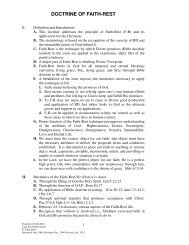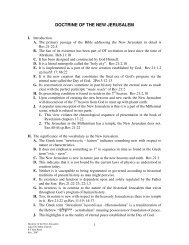Revelation 9 - Lake Erie Bible Church
Revelation 9 - Lake Erie Bible Church
Revelation 9 - Lake Erie Bible Church
You also want an ePaper? Increase the reach of your titles
YUMPU automatically turns print PDFs into web optimized ePapers that Google loves.
Chapter 9<br />
THE REVELATION TO JOHN<br />
4. Again, the exact identification is not the primary issue, but the content of the<br />
message.<br />
5. As with the eagle in Rev.8:13, the number “one/e i = j – heis” is used here with a<br />
specific noun, “voice” to indicate a single or solitary voice that John heard.<br />
6. Some linguists have suggested that the number one is being used in place of an<br />
indefinite article, yet the nature of this cardinal adjective indicates a definitive object.<br />
7. Its emphasis is to denote a contrast to more than one and hence the single most<br />
important voice that John will hear with this judgment. Cp.Vs.16<br />
8. It is designed to draw the student’s attention to the extreme importance of the<br />
message that will immediately follow.<br />
9. The voice is said to come out from the four horns of the golden altar of incense.<br />
10. Some conclude that this mysterious voice cannot be God’s since all this happens<br />
before God. (Beasley-Murray, Osborne, Keithley).<br />
11. Others suggest it is that of the angel that presented the prayers of the Saints to God in<br />
Rev.8:3.<br />
12. Still others suggest this is a collective singular of all the Saints continuing to pray for<br />
vengeance from the altar (Swete).<br />
13. The difficulty in approaching it from a human perspective is that there is no evidence<br />
that human beings are given the authority to command the angelic hosts as to God’s<br />
directives for them in this book.<br />
14. Another grammatical issue is that the opening participle of vs.14 “one saying/ le,gw –<br />
lego” is masculine and singular, while its potential contextual antecedents of “one<br />
voice” or “horns” are feminine and neuter/plural in that order.<br />
15. The grammatical resolution is found in the symbolism of the altar of incense as it<br />
relates to God.<br />
16. The horns of the altar typologically denote the power of prayer pointing to the<br />
prayers of the Saints as now being answered by the power of God.<br />
17. Therefore the altar is personified as receiving the prayers for vengeance and is<br />
responding by instigating vengeance.<br />
18. The one voice itself, whether an angel or God (both masculine) images the<br />
Sovereignty of God in response.<br />
19. The definitive voice is God’s Sovereignty declaring execution of the POG as it<br />
pertains to this judgment, no matter who speaks it. Rev.16:17; 19:5; 21:3<br />
20. It is the principle of sovereignty and right to rule that now becomes the underlying<br />
theme behind this woe and the central theme behind the final woe. Rev.11:15<br />
21. This provides further confirmation that chronologically we are now only hours away<br />
from the Day of the Lord proper.<br />
22. Further, the connective strings of definite articles with all that is associated with the<br />
altar links the calls for vindication of prayers to what is happening here.<br />
23. That vindication formally begins with the Day of the Lord that will take human<br />
history into the Millennium and into the Eternal state. See Doctrine of the Day of the<br />
Lord<br />
24. The male voice/God’s Sovereignty then gives a direct command in vs.14, “saying to<br />
the sixth angel who had the trumpet, ‘Release the four angels who are bound at<br />
the great river Euphrates’”.<br />
<strong>Lake</strong> <strong>Erie</strong> <strong>Bible</strong> <strong>Church</strong><br />
P-T Ken Reed<br />
24










